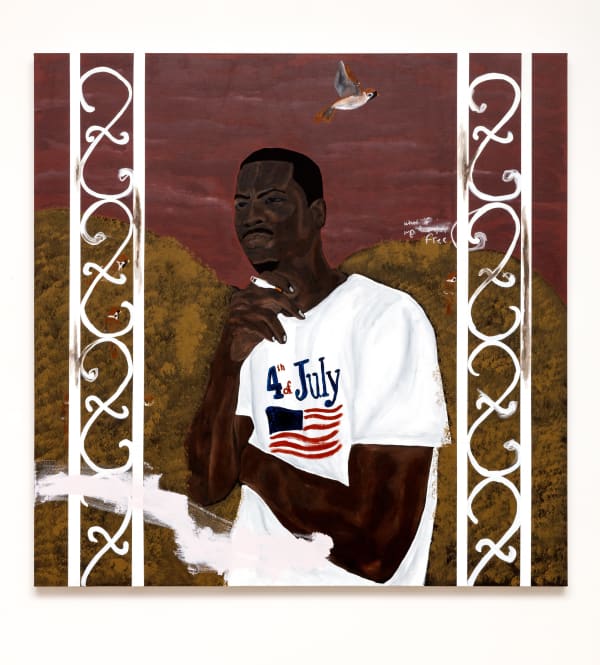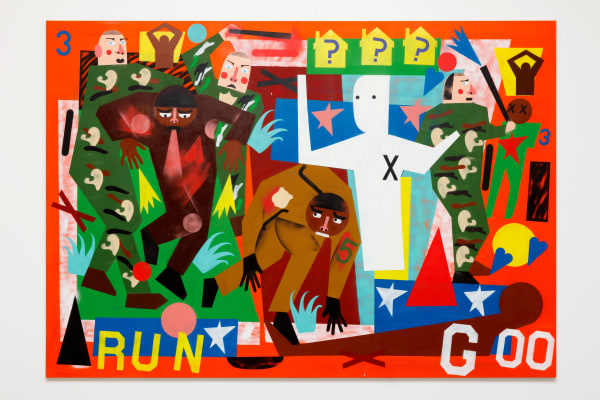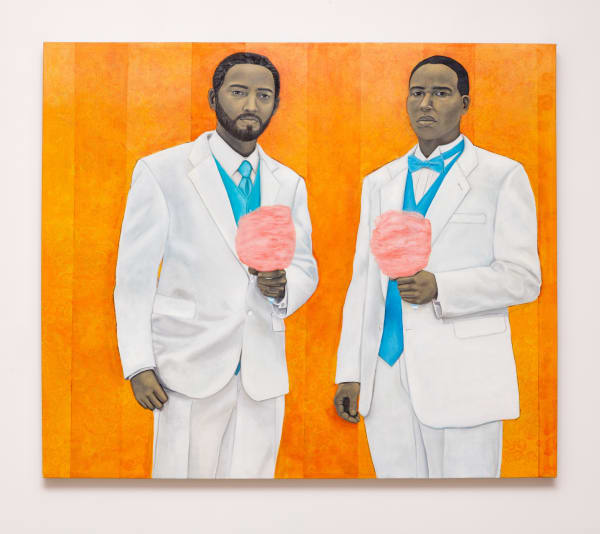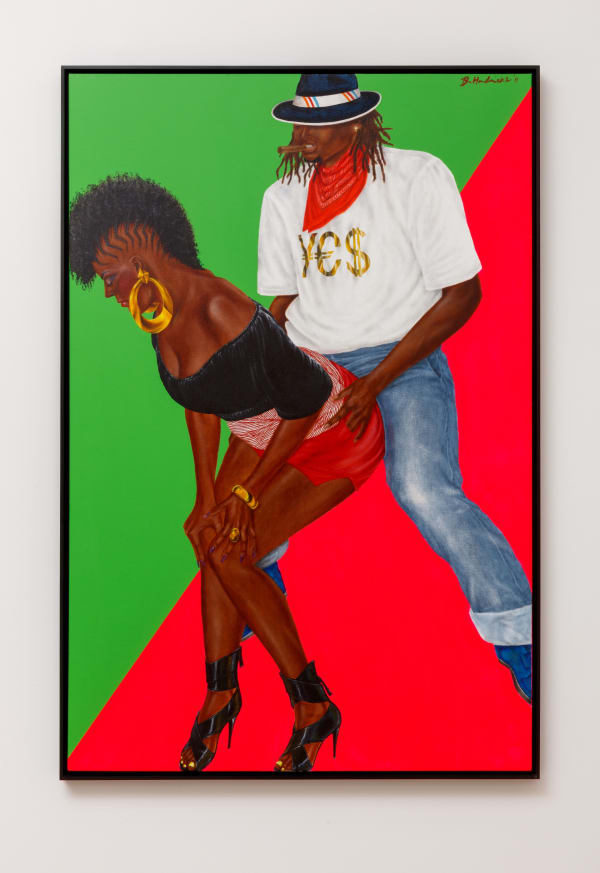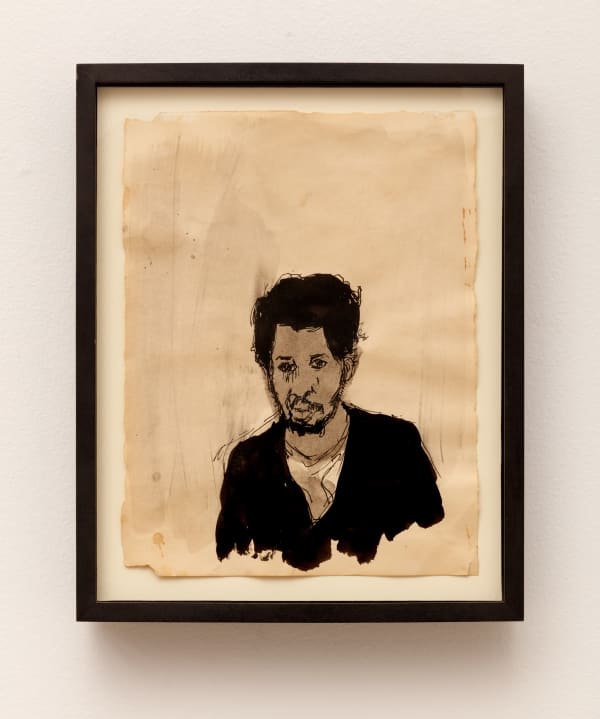Black Bodies, White Spaces: Invisibility & Hypervisibility: Curated by Aindrea Emelife
-
 Jammie HolmesThe Illusion, 2021Acrylic and oil pastel on canvas72 x 72 in.
Jammie HolmesThe Illusion, 2021Acrylic and oil pastel on canvas72 x 72 in. -
 Joy LabinjoYou can ask me all the questions and I'll tell you the truth about the boys in blue, 2021Oil on canvas70 7/8 x 78 3/4 in.
Joy LabinjoYou can ask me all the questions and I'll tell you the truth about the boys in blue, 2021Oil on canvas70 7/8 x 78 3/4 in. -
 Amoako BoafoSteve Mekoudja, 2019Oil on canvas92 1/2 x 63 in.
Amoako BoafoSteve Mekoudja, 2019Oil on canvas92 1/2 x 63 in. -
 Dominic ChambersReverie in Blue (Kayla), 2021Oil on linen66 x 56 in.
Dominic ChambersReverie in Blue (Kayla), 2021Oil on linen66 x 56 in.
-
 Henry TaylorAncestors of Ghenghis Khan with Black Man on horse, 2015-17Acrylic on canvas104 x 250 in.
Henry TaylorAncestors of Ghenghis Khan with Black Man on horse, 2015-17Acrylic on canvas104 x 250 in. -
 Nina Chanel AbneyAlways Ready, Always There, 2018Acrylic and spray paint on canvas84 x 120 in.
Nina Chanel AbneyAlways Ready, Always There, 2018Acrylic and spray paint on canvas84 x 120 in. -
 David HammonsUntitled, 1974Body print39 3/4 x 31 7/8 in.
David HammonsUntitled, 1974Body print39 3/4 x 31 7/8 in. -
 Amy SheraldHigh Yella Masterpiece: We Ain't No Cotton Pickin' Negroes, 2011Oil on canvas59 x 69 in.
Amy SheraldHigh Yella Masterpiece: We Ain't No Cotton Pickin' Negroes, 2011Oil on canvas59 x 69 in.
-
 Toyin Ojih OdutolaLip-Biting Through Grace, 2018Pastel, charcoal and graphite on paper58 1/2 x 42 1/8 in.
Toyin Ojih OdutolaLip-Biting Through Grace, 2018Pastel, charcoal and graphite on paper58 1/2 x 42 1/8 in. -
 Deborah RobertsMoving Target, 2018Mixed media and collage on paper67 1/2 x 48 in.
Deborah RobertsMoving Target, 2018Mixed media and collage on paper67 1/2 x 48 in. -
 Jameson GreenEvery N*gga is a Star!, 2021Oil on linen78 x 66 in.
Jameson GreenEvery N*gga is a Star!, 2021Oil on linen78 x 66 in. -
 Barkley L. HendricksPassion Dancehall #1, 2011Oil and acrylic and linen on canvas72 x 48 in.
Barkley L. HendricksPassion Dancehall #1, 2011Oil and acrylic and linen on canvas72 x 48 in.
-
 Mickalene ThomasAll She Wants To Do Is Dance (Fran), 2009Rhinestones, acrylic on enamel wood panel120 x 95 3/4 in.
Mickalene ThomasAll She Wants To Do Is Dance (Fran), 2009Rhinestones, acrylic on enamel wood panel120 x 95 3/4 in. -
 Jordan CasteelAto, 2014Oil on canvas72 x 54 in.
Jordan CasteelAto, 2014Oil on canvas72 x 54 in. -
 Robert H. Colescott, Hard Time, 1982
Robert H. Colescott, Hard Time, 1982 -
 Ludovic NkothHolding on to Hope, 2020Acrylic and sand on canvas60 x 48 in.
Ludovic NkothHolding on to Hope, 2020Acrylic and sand on canvas60 x 48 in.
-
 Derek FordjourTwo Point Bend, 2019Acrylic, charcoal, oil pastel, and foil on newspaper mounted on canvas40 x 60 in.
Derek FordjourTwo Point Bend, 2019Acrylic, charcoal, oil pastel, and foil on newspaper mounted on canvas40 x 60 in. -
 Otis Kwame Kye QuaicoeBeret Boys 2, 2021Oil on canvas60 x 40 in.
Otis Kwame Kye QuaicoeBeret Boys 2, 2021Oil on canvas60 x 40 in. -
 Danielle MckinneyFirst Glance, 2021Acrylic on canvas24 x 18 in.
Danielle MckinneyFirst Glance, 2021Acrylic on canvas24 x 18 in. -
 Darrel EllisUntitled (Self-Portrait), c. 1990Ink and wash on paper11 1/2 x 9 in.
Darrel EllisUntitled (Self-Portrait), c. 1990Ink and wash on paper11 1/2 x 9 in.
“Not everything that is faced can be changed. But nothing can be changed until it has been faced. History is not the past. It is the present. We carry our history with us. We are our history.” – James Baldwin
What we see is political. Taking up space is resistance. Walking through the gallery space hung with pictures, museum-goers act out and internalise a version of history… what happens when this space is infiltrated by those history has sought to exclude? With Black Bodies, White Spaces: Invisibility and Hypervisibility we see the coming together of artists exploring the Black Body in painting and posit how doing so is a form of resistance.
Inspired in part by the pivotal 20th century text “Black Skin White Masks” by French philosopher Frantz Fanon, this exhibition explores how artists have critiqued navigated, and engaged with the complexity of constructed and produced Blackness.
The work in this show depicts a legacy of artists who have expanded the artistic language and public understanding of the role and function of ‘Black art’. From David Hammons’ body prints to Henry Taylor’s Guernica-style bandit scene, Mickalene Thomas’ defiant woman to JadéFadojutimi’s explorations of the body and gesture through abstraction, this exhibition extols the multiplicity of the body and the modes of representing Blackness through it. Nina Chanel Abney’s Playmobil colored activism coaxes us to question the ethics of authority and sanctioned violence, whilst Amy Sherald’s cotton-candy colored figures subvert the symbols of oppression in a powerful pastel reclamation. Barkley Hendricks celebrates Black culture and self-determination with his colorful dancing couple, whilst Toyin Ojih Odutola’s steady repertoire of figures seem braided from scintillating coarse silks, bringing her charcoal musings into more stark chromatic ranges to depict upper-class Nigerian families. Furthermore, Danielle McKinney and Jordan Casteel create introspective depictions of leisure and vulnerability. Blackness is so often aligned with strength and defiance, yet these artists remind us that softness and delicateness touches us all.
Black figuration is not a monolith. The exhibition purposefully incorporates an international perspective, unveiling the nuances of the Black British experience in Joy Labinjo’s powerful rendition of the British police system and how this intersects with race. Otis Kwame Kye Quaicoe’s colourful beret-wearing youths and Amoako Boafo’s power blue suited gentlemen unveil Ghanaian’s colourful approach to fashion. They achieve this by representing the political use of style, subverting conventional notions of Blackness, maleness and how Black dandyism refutes a single construction of Black masculinity. The artists selected dismantle the function and purpose of art, refashioning it to create dynamic investigations that hold art and its pre-conceptions accountable and demand more from the medium and the viewer.
-

Installation view, Black Bodies, White Spaces: Invisibility & Hypervisibility, 2021. Todora Photography
-

Installation view, Black Bodies, White Spaces: Invisibility & Hypervisibility, 2021. Todora Photography
-

Installation view, Black Bodies, White Spaces: Invisibility & Hypervisibility, 2021. Todora Photography
-

Installation view, Black Bodies, White Spaces: Invisibility & Hypervisibility, 2021. Todora Photography
-

Installation view, Black Bodies, White Spaces: Invisibility & Hypervisibility, 2021. Todora Photography
-

Installation view, Black Bodies, White Spaces: Invisibility & Hypervisibility, 2021. Todora Photography
-

Installation view, Black Bodies, White Spaces: Invisibility & Hypervisibility, 2021. Todora Photography
-

Installation view, Black Bodies, White Spaces: Invisibility & Hypervisibility, 2021. Todora Photography
-

Installation view, Black Bodies, White Spaces: Invisibility & Hypervisibility, 2021. Todora Photography
-

Installation view, Black Bodies, White Spaces: Invisibility & Hypervisibility, 2021. Todora Photography
-

Installation view, Black Bodies, White Spaces: Invisibility & Hypervisibility, 2021. Todora Photography
-

Installation view, Black Bodies, White Spaces: Invisibility & Hypervisibility, 2021. Todora Photography
-

Installation view, Black Bodies, White Spaces: Invisibility & Hypervisibility, 2021. Todora Photography
-

Installation view, Black Bodies, White Spaces: Invisibility & Hypervisibility, 2021. Todora Photography
-

Installation view, Black Bodies, White Spaces: Invisibility & Hypervisibility, 2021. Todora Photography
-
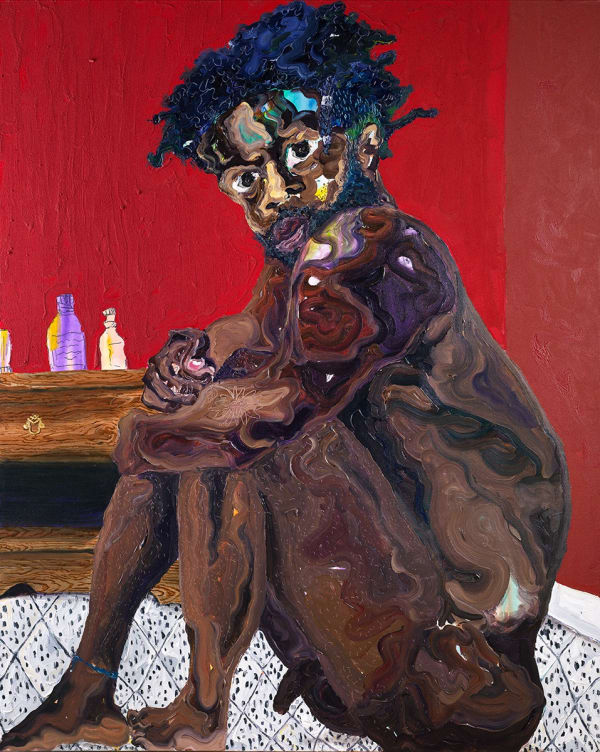
Black Bodies, White Spaces Exhibition Tackles White Gatekeeping in Art and Other Issues
Kian Hervey, Dallas Observer, January 19, 2022 This link opens in a new tab. -
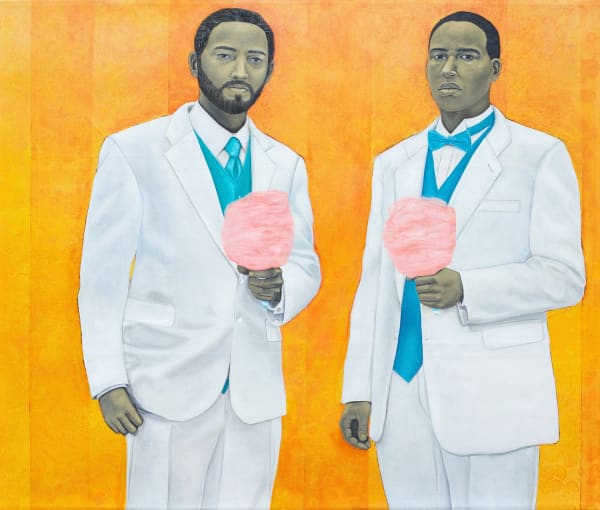
‘Black Bodies, White Spaces’ features some of the most important living Black artists
Darryl Ratcliff, The Dallas Morning News, December 29, 2021 This link opens in a new tab. -

New Art Space in Dallas Brings One Family’s Impressive Collection to the Public
Lauren Moya Ford, Artsy, October 15, 2021 This link opens in a new tab. -
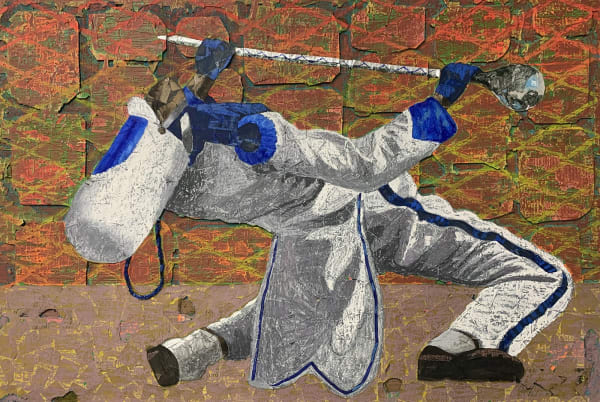
Blackness as Joy, Leisure, and Excellence
Terri Provencal, Patron Magazine, October 1, 2020 This link opens in a new tab.
The Green Family Art Foundation is pleased to announce its inaugural exhibition Black Bodies, White Spaces: Invisibility & Hypervisibility, an exhibition curated by London-based curator Aindrea Emelife, opening on October 9, 2021 and remaining on view until January 27, 2022.
“What we see is political. Taking up space is resistance. Walking through the gallery space hung with pictures, museum-goers act out and internalize a version of history... what happens when this space is infiltrated by those history has sought to exclude? With Black Bodies, White Spaces: Invisibility & Hypervisibility we see the coming together of artists exploring the Black body in painting and posit how doing so is a form of resistance.” – Aindrea Emelife, curator
Inspired in part by the pivotal 20th century text “Black Skin, White Masks” by French philosopher Frantz Fanon, this exhibition explores how artists have critiqued, navigated, and engaged with the complexity of constructed and produced Blackness.
Artists include:
|
Nina Chanel Abney |
Jadé Fadojutimi |
Jammie Holmes |
Otis Kwame Kye Quaicoe |
|
Amoako Boafo |
Derek Fordjour |
Joy Labinjo |
Deborah Roberts |
|
Jordan Casteel |
Jameson Green |
Danielle Mckinney |
Amy Sherald |
|
Dominic Chambers |
David Hammons |
Ludovic Nkoth |
Henry Taylor |
|
Robert Colescott |
Barkley L. Hendricks |
Toyin Ojih Odutola |
Mickalene Thomas |
|
Darrel Ellis |
|
|
|
The work in this show depicts a legacy of artists who have expanded the artistic language and public understanding of the role and function of ‘Black art’. From David Hammons’ seminal, politicized printing plate body prints to Henry Taylor’s Guernica-style bandit scene, Mickalene Thomas’ defiant woman to Jadé Fadojutimi’s explorations of the body and gesture through abstraction, this exhibition extols the variability of the body and the modes of representing Blackness through it. Nina Chanel Abney’s Playmobil colored activism coaxes us to question the ethics of authority and sanctioned violence, as does Joy Labinjo’s rendition of a polite, helping British police offer, while Amy Sherald's cotton candy-colored figures subvert the symbols of oppression in a powerful pastel reclamation of manhood. Barkley L. Hendricks celebrates Black culture and self-determination with his colorful dancing couple who are free to dance as they wish, while Toyin Ojih Odutola’s depiction of imaginary upper class Nigerian families, dressed in chromatic and scintillating silks, upturn western perceptions of the color of royalty. Furthermore, Danielle Mckinney and Jordan Casteel create introspective depictions of leisure and vulnerability removing the “otherness” taint of the Black body. Blackness is so often aligned with strength and defiance, yet these artists remind us that softness and delicateness touches us all.
Black figuration is not a monolith. The exhibition purposefully incorporates an international perspective, unveiling not only Joy Labinjo’s subtle but powerful commentary about authority, but also Otis Kwame Kye Quaicoe’s colorful beret-wearing youths and Amoako Boafo’s power blue suited gentleman, both of which, along with Amy Sherald's work, show Blackness that is dressed for success. They achieve this by representing the political use of style, subverting conventional notions of Blackness, maleness and how Black dandyism refutes a single construction of Black masculinity. The artists selected dismantle the function and purpose of art, refashioning it to create dynamic investigations that hold art and its pre-conceptions accountable and demand more from the medium and the viewer.
About the Curator:
Aindrea Emelife is a 27-year-old independent curator from London. Starting at the Courtauld Institute of Art, Emelife fuses art history with contemporary art to explore the realms of representation, identity, social justice and desire in her curatorial and writing practice. In 2021, she was appointed to the Mayor of London's Commission for Diversity in the Public Realm and listed in Forbes 30 Under 30. Recent exhibitions include Citizens of Memory, The Perimeter London (2021) and her forthcoming books, A Little History of Protest Art (Tate) and Art Can Change The World (Frances Lincoln) debut in 2022.
About The Green Family Art Foundation:
The Green Family Art Foundation is a non-profit 501(c)(3) organization.
The foundation’s mission is to provide a venue for, make grants to museums for the benefit of, and educate others about contemporary artists we believe communicate important ideas that are relevant and discussion worthy today and in the future.
The exhibition is located at 150 Manufacturing Street Suite 214, Dallas, TX 75207. Admission is free, proof of vaccination is required for entry. For press inquiries, please reach out to info@greenfamilyartfoundation.org or call 214-274-5656.
